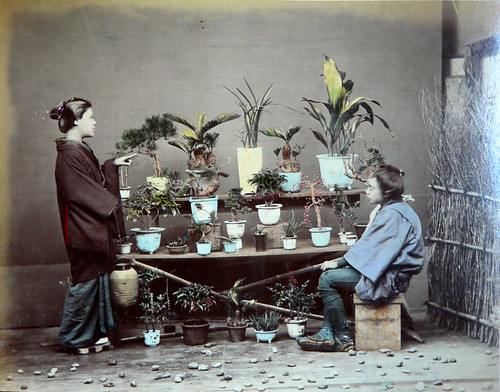Words of an Italian Bonsai Professional
This is a blog about Bonsai.
Posted on 3:51 by Harutomo | 0 コメント
Posted on 3:24 by Harutomo | 0 コメント
A design covers another design. This possibility and idea are quite potential in all kinds of fields. What is the meaning of designing bonsai plats which are already done with a "design?" For example, "this bonsai is designed by a famous Japanese guy" but, thatarchitecture is designed by piano design SMEG." The hint is that bonsai as a product and even as a design should be treated as a special thing.

| Smeg and architectural studio PIANO DESIGN, have created a new way of caring for houseplants: the Home Garden. Clean, essential lines combine with elegant materials like toughened glass and steel to give full visibility of the potted plants kept inside. Designed as a furnishing accessory and "activity center", the Home Garden is both useful and beautiful. |
Posted on 22:15 by Harutomo | 0 コメント

While bonsai has widespread and become a well-known thing in Italy, it is normal to think when and what is the original trigger that bonsai was introduced to Italy. It actually dates back to the 1880s, about 130 years ago with a guy called Adolfo Farsari.
Posted on 6:56 by Harutomo | 0 コメント
Posted on 6:28 by Harutomo | 0 コメント


How people who are into bonsai get useful infornation about bonsai? There are some ways as we can imagine such as TV, internet, schools and so on. Of all, magazines are the most reliable and easy to get access for every kind of people. In Italy, there is a number of magazines which specialized in only bonsai. The following two magazines are most well-known and sold in this country.
1)
publisher: UBI (Unioni Bonsai Italiani )
pages:A4, 56pages 4 times in a year
number of publishing:1,800
2)
publisher:Crespi Editori
pages:A4, 70~80pages, every 2 manths
year of foundation:1990年
price:€6.0、annual subscription €32.50
Posted on 7:42 by Harutomo | 0 コメント


Posted on 6:54 by Harutomo | 0 コメント
Almost 30 years have passed since Italy has started importing bonsai from Japan. Bonsai has only 30 year-history in this country. Nowadays, however, everyone recognizes the term of "bonsai" regardless of age or gender, and many people enjoy it. How has bonsai got so popular here?
Crespi Bonsai(Crespi Srl.)
S 33 del Sempione 37
2015 Parabiago (MI)
Tel:31.491850
Email:info@crespibonsai.com
http://www.crespibonsai.com
<Milan>
Via Boccaccio, 4 20123 Milano
Tel:02.48193301
<Brescia>
Via Saffi, 1 25100 Brescia
Tel:030 3772832

After Crespi Bonsai, other companies followed it one after another such as
Oltreil Verde http://www.oltreilverde.com/
Franchi Bonsai VIVA I http://www.franchi-bonsai.it/
Barbaza Bonsai http://www.barbazzabonsai.it/
Fuji Sato Comapany http://www.fujisato.it/chisiamo_eng/index.html




Posted on 6:04 by Harutomo | 0 コメント
Bonsai has become a business. It is a huge business in some particular countries. In 2008, Animal Quarantine Service Ministry of Agriculture, Forestry and Fisheries of Japan announced an interesting data, in the previous year (2007,) which shows the total amount of money of exported Bonsai from Japan and a breakdown by country as it is shown below:
The total amount:
¥5,452,500,000 (≒$46,207,627.1) [$1≒¥118 (2007)]
No.1: Netherlands (20%)
No.2: The UK (15%)
No.3: Spain (14%)
No.3: Taiwan (14%)
No.4: Italy (13%)
No.5: Germany (5%)
Surprisingly, except Taiwan, the dominants are European countries. Although Italy was ranked in no.4, it still showed a quite number. When it comes to the data in 2004, as another surprising thing, the total amount was only ¥890,000,000, which is about 1/6. The market had become more than 6 times bigger in 3 years. Yes, the Bonsai market was a really attractive! Yes...it "was..."
(To be continued)
Posted on 9:33 by Harutomo | 0 コメント
 For your own to appreciate or for your friends or steady to gift, have a super-small Bonsai. This may be the best one to begin Bonsai and understand its "world." You do not have to be bothered to look for some space to display it. Plus, you do not need to consult with your wallet. It is quite cheap. Having around €20, you can get this cute one! This is not only small. This has a "world." Plus, you do not have to go to a shop. You can buy it online. This cute one is sold at "Izu-Bonsai Online shop," (naruko@izubonsai.com
For your own to appreciate or for your friends or steady to gift, have a super-small Bonsai. This may be the best one to begin Bonsai and understand its "world." You do not have to be bothered to look for some space to display it. Plus, you do not need to consult with your wallet. It is quite cheap. Having around €20, you can get this cute one! This is not only small. This has a "world." Plus, you do not have to go to a shop. You can buy it online. This cute one is sold at "Izu-Bonsai Online shop," (naruko@izubonsai.com![]()
) located in Shizuoka Prefecture in Japan.
This super-small Bonsai will lead you to Bonsai World. Once you get into the world, you will definitely buy some more bonsai. Then, you will get a shelf for them as a small "gallery"
Posted on 10:17 by Harutomo | 0 コメント
What do you associate with the words "minimal" and "progressive"? Some people may immediately think about music genre, especially in electro music. Bonsai accompanies these two words, I believe. The explanation for "minimal" is quite easy. As its appearance, it is, most of the time, small, compact, and plain. They are just same characteristic as minimal music. What about "progressive"? It is a bit deeper idea, I would say. Anyway, have you seen any CD jackets of progressive music in electronic? Actually, they are quite colorful. I mean they tend to be with different and more colors, compared to that of minimal. Apparently, bonsai is not so colorful. Yet, bonsai is a plant, living in seasons. So depending on the seasons, it changes its color, naturally. Also, pots for bonsai are not just a container but they are usually a pottery nicely designed by pottery craftsmen. What's more,"progressive" is more about chronology. Again, bonsai is a plant. Its figure has changed over time, extremely slowly, though. Here, I show examples of minimal and progressive music and their CD jackets.
tittle: Summer Star (Original Mix)
artist: Kostas Skretas
year: 2009
genre: Progressive House
tittle: Alnitak (Dark Side)
artist: Danilo Vigorito
year: 2008
genre: Minimal Techno